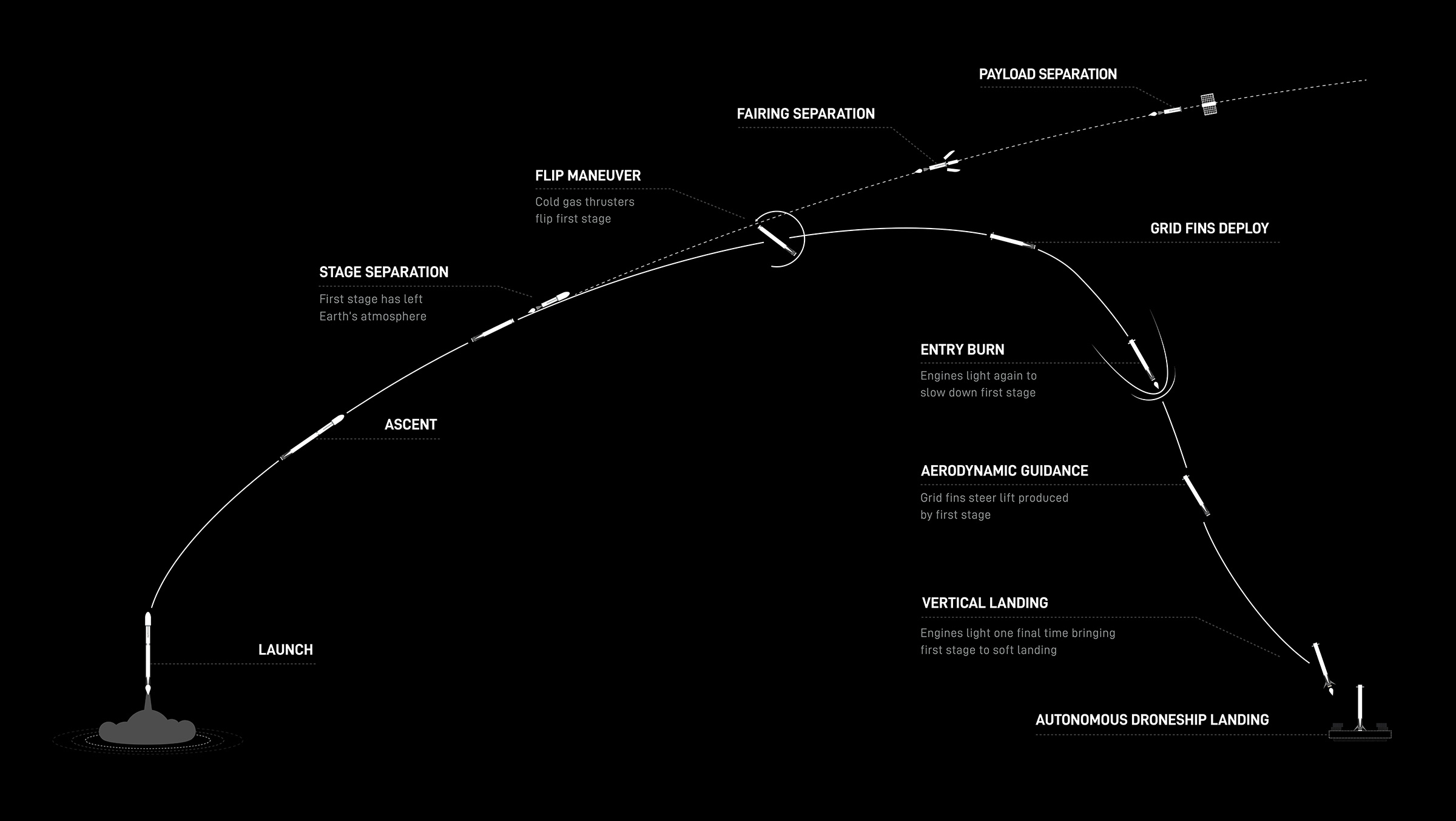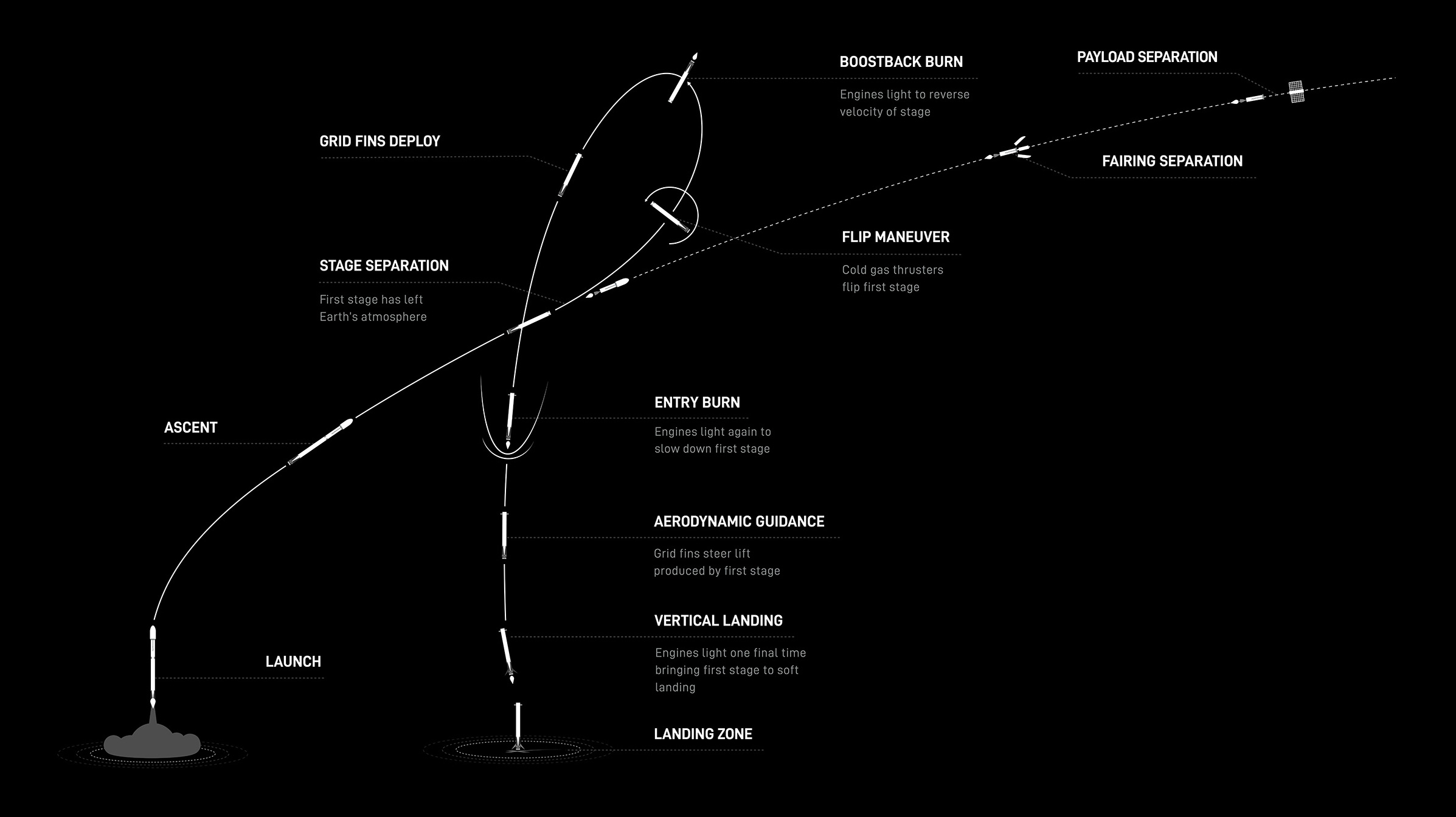About
Falcon 9 is a reusable, two-stage rocket designed and manufactured by SpaceX for the reliable and safe transport of people and payloads into Earth orbit and beyond. Falcon 9 is the world’s first orbital class reusable rocket. Reusability allows SpaceX to refly the most expensive parts of the rocket, which in turn drives down the cost of space access.
Specifications
| HEIGHT | 70 m / 229.6 ft |
| DIAMETER | 3.7 m / 12 ft |
| MASS | 549,054 kg / 1,207,920 lb |
| PAYLOAD TO LEO | 22,800 kg / 50,265 lb |
| PAYLOAD TO GTO | 8,300 kg / 18,300 lb |
| PAYLOAD TO MARS | 4,020 kg / 8,860 lb |
First Stage
Overview
Falcon 9’s first stage incorporates nine Merlin engines and aluminum-lithium alloy tanks containing liquid oxygen and rocket-grade kerosene (RP-1) propellant. Falcon 9 generates more than 1.7 million pounds of thrust at sea level.
First Stage Merlin Engines
First Stage Merlin Engines
The nine Merlin engines on the first stage are gradually throttled near the end of the first-stage flight to limit launch vehicle acceleration as the rocket’s mass decreases with the burning of fuel. These engines are also used to reorient the first stage prior to reentry and to decelerate the vehicle for landing.
| NUMBER OF ENGINES | 9 |
| THRUST AT SEA LEVEL | 7,607 kN / 1,710,000 lbf |
| THRUST IN VACUUM | 8,227 kN / 1,849,500 lbf |
Landing Legs
Landing Legs
The Falcon 9 first stage is equipped with four landing legs made of state-of-the-art carbon fiber with aluminum honeycomb. Placed symmetrically around the base of the rocket, they are stowed at the base of the vehicle and deploy just prior to landing.
Second Stage
The second stage, powered by a single Merlin Vacuum Engine, delivers Falcon 9’s payload to the desired orbit. The second stage engine ignites a few seconds after stage separation, and can be restarted multiple times to place multiple payloads into different orbits.
| NUMBER OF ENGINES | 1 vacuum |
| BURN TIME | 397 sec |
| THRUST | 981 kN / 220,500 lbf |
InterStage
The interstage is a composite structure that connects
the first and second
stages and houses the pneumatic pushers that allow the first and second
stages to separate during flight.
GRID FINS
Falcon 9 is equipped with four hypersonic grid fins positioned at the base
of the interstage. They orient the rocket during reentry by moving the
center of pressure.
Payload
Fairing
Made of a carbon composite material, the fairing protects satellites on their way to orbit. The fairing is jettisoned approximately 3 minutes into the flight, and SpaceX continues to recover fairings for reuse on future missions.
| HEIGHT | 13.1 m / 43 ft |
| DIAMETER | 5.2 m / 17.1 ft |
Payload
Dragon
Dragon is capable of carrying up to 7 people and/or cargo in the spacecraft’s pressurized section. In addition, Dragon can carry cargo in the spacecraft’s unpressurized trunk, which can also accommodate secondary payloads.
| HEIGHT | 8.1 m / 26.6 ft |
| DIAMETER | 3.7 m / 12 ft |
Merlin Engine
Sea Level
Merlin is a family of rocket engines developed by SpaceX for use on its Falcon 1, Falcon 9, and Falcon Heavy launch vehicles. Merlin engines use rocket-grade kerosene (RP-1) and liquid oxygen as rocket propellants in a gas-generator power cycle. The Merlin engine was originally designed for recovery and reuse.
| PROPELLANT | LOX / RP-1 |
| THRUST | 845 kN / 190,000 lbf |
Merlin Engine
Vacuum
Merlin Vacuum features a larger exhaust section and a significantly larger expansion nozzle to maximize the engine’s efficiency in the vacuum of space. Its combustion chamber is regeneratively cooled, while the expansion nozzle is radiatively cooled. At full power, the Merlin Vacuum engine operates with the greatest efficiency ever for an American-made hydrocarbon rocket engine.
| PROPELLANT | LOX / RP-1 |
| THRUST | 981 kN / 220,500 lbf |
History
Falcon 1 could place a 1,010-kg (2,227-pound) payload into orbit at lower cost than other launch vehicles. Falcon 9 was designed to compete with the Delta family of launchers in that it can lift payloads of up to 8,300 kg (18,300 pounds) to geostationary orbit. One payload it launched to low Earth orbit is Dragon, a spacecraft designed to carry crew and cargo to the International Space Station (ISS). Two subsequent tests of Falcon 1 ended in failure, but on September 28, 2008, Falcon 1 successfully entered Earth orbit. Falcon 1 made one more flight in 2009 and was retired in favor of Falcon 9. The first test flight of Falcon 9 was on June 4, 2010, from Cape Canaveral, Florida, and the first resupply mission to the ISS was made on October 7, 2012. In 2014 tests began on a reusable first stage for the Falcon 9 that would land on a floating platform. On December 21, 2015, a Falcon 9 launched a payload into orbit, and its first stage made a landing at Cape Canaveral. The first Falcon 9 first-stage ship landing happened on April 8, 2016, and SpaceX did its first relaunch of a previously-flown Falcon 9 first stage on March 30, 2017.


First Flight
4 June 2010, First flight of Falcon 9 v1.0.[11] Used a boilerplate version of Dragon capsule which was not designed to separate from the second stage. Attempted to recover the first stage by parachuting it into the ocean, but it burned up on reentry before the parachutes even go to deploy.
Reusability
SpaceX believes a fully and rapidly reusable rocket is the pivotal breakthrough needed to substantially reduce the cost of space access. The majority of the launch cost comes from building the rocket, which historically has flown only once. Compare that to a commercial airliner – each new plane costs about the same as Falcon 9 but can fly multiple times per day and conduct tens of thousands of flights over its lifetime. Following the commercial model, a rapidly reusable space launch vehicle could reduce the cost of traveling to space by a hundredfold. While most rockets are designed to burn up on reentry, SpaceX rockets can not only withstand reentry but can also successfully land back on Earth and refly again.
Droneship Landing

Landing Zone



